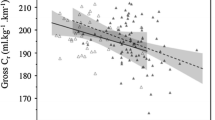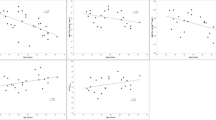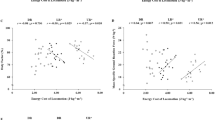Summary
To highlight the influences of age, sex, body mass (m b) and running training on the energy cost of running (C r) young basketball players [38 boys (BB) and 14 girls (BG), aged 14.2 (SD 0.3) and 12.2 (SD 1.9) years, respectively] were selected to be compared to middle-distance runners [27 men (MR) and 14 women (FR) aged 23.7 (SD 3.4) and 23.9 (SD 4.1) years, respectively]. TheC r was measured during a maximal treadmill test. In each groupC r and body mass (m b) and body height were negatively and significantly correlated. A stepwise regression showed that among both the body dimensions measured,m b was the most important factor in determining the variations ofC r For the whole group (n=93) the correlation coefficient was 0.72 (P<0.0001). For a givenm b, there was no significant difference between theC r of BG, BB and MR: this result would support the hypothesis that the differences inC r currently attributed to age, running training or sex differences are mainly related tom b. On the other hand, for a givenm b, FR showed a significantly lower Cr than the basketball players (P<0.01 for BG and BB) and than MR (P<0.05), thus suggesting that women decrease theirC r as a response to running training more efficiently than do men.
Similar content being viewed by others
References
Åstrand PO (1952) Experimental studies of physical working capacity in relation to sex and age. Munsksgaard, Copenhagen
Bailey S, Pate R (1991) Feasibility of improving running economy. Sports Med 12:228–236
Bergh U, Sjodin B, Forsberg A, Svedenhag J (1991) The relationship between body mass and oxygen uptake during running in humans. Med Sci Sports Exerc 23:205–211
Brambhani Y, Singh M (1985) Metabolic and cinematographic analysis of walking and running in men and women. Med Sci Sports 17:131–137
Bransford DR, Howley ET (1977) Oxygen cost of running in trained and untrained men and women. Med Sci Sports 9:41–44
Brueckner JC, Atchou G, Capelli C, Duvallet A, Barrault D, Jousselin E, Rieu M, di Prampero PE (1991) The energy cost of running increases with the distance covered. Eur J Appl Physiol 62:385–389
Bunc V, Heller J (1989) Energy cost of running in similary trained men and women. Eur J Appl Physiol 59:178–183
Cavagna GA, Sabeine FP, Margaria R (1964) Mechanical work in running. J Appl Physiol 19:249–256
Cavanagh P, Williams K (1982) The effect of stride length variations on oxygen uptake during distance running. Med Sci Sports Exerc 14:30–35
Conley D, Krahenbuhl G (1980) Running economy and distance running performance of highly trained athletes. Med Sci Sports Exerc 12:357–360
Conley D, Krahenbuhl G, Burkett L (1981) Training for aerobic capacity and running economy. Phys Sportsmed 9:107–115
Conley D, Krahenbuhl G, Burkett L, Milar L (1984) Following Steve Scott: physiological changes accompanying training. Phys Sportsmed 12:103–106
Cooke CB, McDonagh JN, Nevill AM, Davies CTM (1991) Effects of load on oxygen intake in trained boys and men during treadmill running. J Appl Physiol 71:1237–1244
Daniels JT (1985) Symposium: a physiologist's view or running economy. Med Sci Sports 17:332–338
Daniels J, Daniels N (1992) Running economy of elite male and elite female runners. Med Sci Sports Exerc 24:483–489
Daniels J, Krahenbuhl G, Foster C, Gilbert J, Daniels S (1977) Aerobic responses of female distance runners to submaximal and maximal exercice. In: Milvy P (ed) The marathon: physiological, medical and psychological studies, New York. Annals NY Acad Sci, pp 726–733
Daniels J, Oldridge N (1971) Changes in oxygen consumption of young boys during growth and running training. Med Sci Sports 3:161–165
Daniels J, Oldridge N, Nagle F, White B (1978) Differences and changes in\(\dot V\)O2 among young runners 10 to 18 years of age. Med Sci Sports 10:200–203
Daniels J, Scardina N, Hayes J, Foley P (1986) Elite and subelite female middle- and longdistance runners. In: Landers DM (ed) Sport and elite performers. Human kinetics, Champaign, Ill., pp 57–72
Davies CTM (1980) Metabolic cost of exercise and physical performance in children with some observations on external loading. Eur J Appl Physiol 45:95–102
Di Prampero PE (1986) The energy cost of human locomotion on land and in water. Int J Sports Med 7:55–72
Di Prampero PE, Atchou G, Bruckner JC, Moia C (1986) The energetics of endurance running. Eur J Appl Physiol 55:259–266
Ferretti G, Atchou G, Grassi B, Marconi C, Ceretelli P (1991) Energetics of locomotion in african pygmies. Eur J Appl Physiol 62:7–10
Howley ET, Glover ME (1974) The caloric costs of running and walking one mile for men and women. Med Sci Sports 6:235–237
Kearney J, Van Handel P (1989) Economy: a physiologic perspective. Adv Sports Med Fitness 2:57–90
Komi PV (1986) The stretch-shortening cycle and human power output. In: Jones NL, McCartney N, McComas AJ (eds) Muscle power. Human Kinetics, Champaign, Ill., pp 27–39
Krahenbuhl GS, Williams TJ (1992) Running economy: changes with age during childhood and adolescence. Med Sci Sports Exerc 24:462–466
Krahenbuhl GS, Pangrazi RP, Chomokos EA (1979) Aerobic responses of young boys to submaximal running. Res Q 50:413–421
Krahenbuhl GS, Morgan DW, Pangrazi RP (1989).Longitudinal changes in distance-running performance of young males. Int J Sports Med 10:92–96
Lacour JR, Padilla-Magunacelaya S, Barthelemy JC, Dormois D (1990) The energetics of middle-distance running. Eur J Appl Physiol 60:38–43
MacDougall JD, Roche PD, Bar-Or O, Moroz JR (1983) Maximal aerobic capacity of Canadian schoolchildren: prediction based on age-related oxygen cost of running. Int J Sports Med 4:194–198
Margaria R, Ceretelli P, Aghemo P, Sassi G (1963) Energy cost of running. J Appl Physiol 18:367–370
Mayers N, Gutin B (1979) Physiological characteristics of elite prepubertal cross-country runners. Med Sci Sports 11:172–176
Mayhew JL (1977) Oxygen cost and energy expenditure of running in trained runners. Br J Sports Med 11: 116–121
Medbø JI, Mohn AC, Tabata I, Bahr R, Vaage O, Sejersted O (1988) Anaerobic capacity determined by maximal accumulated O2 deficit. J Appl Physiol 64:50–60
Morgan D, Martin P, Krahenbuhl G (1989) Factors affecting running economy. Sports Med 7:310–330
Padilla S, Bourdin M, Barthélémy JC, Lacour JR (1992) Physiological correlates of middle-distance running performance. A comparative study between males and females. Eur J Appl Physiol 65:561–566
Powers S, Dodd S, Deason R, Byrd R, Mcknight T (1983) Ventilatory threshold, running economy and distance performance of trained athletes. Res Q Exerc Sport 54:179–182
Rowland TW, Green GM (1988) Physiological responses to treadmill exercise in females: adult-child differences. Med Sci Sports Exerc 20:474–478
Simonsen EB, Thomsen L, Klausen K (1985) Activity of mono and bi-articular leg muscles during sprint running. Eur J Appl Physiol 54:524–532
Sparling PB, Cureton KJ (1983) Biological determinants of the sex difference in 12-min run performance. Med Sci Sports Exerc 15:218–223
Taylor CR (1977) The energetics of terrestrial locomotion and body size in vertebrates. In: Pedley TJ (ed) Scale effects in animal locomotion. Academic Press, London, pp 127–141
Thorstensson A (1986) Effects of moderate external loading on the aerobic demand of submaximal running in men and 10 years-old boys. Eur J Appl Physiol 55:569–574
Williams KR, Cavanagh PR, Ziff JL (1987) Biomechanical studies of elite female distance runners. Int J Sports Med 8:107–118
Author information
Authors and Affiliations
Rights and permissions
About this article
Cite this article
Bourdin, M., Pastene, J., Germain, M. et al. Influence of training, sex, age and body mass on the energy cost of running. Europ. J. Appl. Physiol. 66, 439–444 (1993). https://doi.org/10.1007/BF00599618
Accepted:
Issue Date:
DOI: https://doi.org/10.1007/BF00599618




